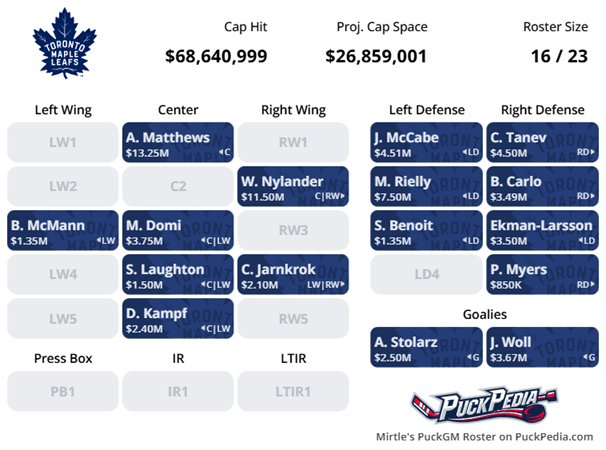
It’s hard to believe, but today marks almost five weeks until NHL free agency opens on July 1.
For the Toronto Maple Leafs, that’s five weeks to prepare for the end of their Core Four era. Five weeks until Mitch Marner (highly, highly likely) and John Tavares (far less likely) become free agents who can sign with the highest bidder.
Advertisement
The challenge for the Leafs and general manager Brad Treliving will be coming up with a game plan for success to spend the $21.9 million freed up, in addition to any other space they can create, and make their roster as good or, ideally, better than it was this past season.
Impossible? No, but it’s certainly going to be pretty difficult given (a) Toronto’s varied needs, (b) a weak free-agent class, and (c) the fact that so many other teams are going to be flush with cap space with the salary cap rising to a record $95.5 million.
I don’t think it’s hyperbole to say that this will be the most complex and important offseason the Leafs have had in a very long time. Maybe of the cap era. They need to thread the needle by making a series of smart decisions, being cutthroat and also being creative. Here’s a quick look at what that might look like throughout the roster.
How much cap space do the Leafs have?
So, if the Leafs don’t do anything, putting Potato GM in charge, where do they stand?
Jake McCabe and Joseph Woll have raises kicking in, boosting their salaries considerably. But with the cap going up $7.5 million and Marner ($10.9 million) and Tavares ($11 million) off the books, this is what things look like before any free agents are taken into consideration.
I’ve slotted everyone where they spent most of the playoffs, so you can see the openings.
Interestingly, the Leafs are set on the blue line and in goal, barring trades. That leaves rebuilding the forwards as the obvious primary task for Treliving.
Given that five of the seven forwards they have signed were part of a very underwhelming bottom-six this season, including a poor showing in the playoffs, the main goal needs to be injecting more talent up front. The Leafs looked like a two-line team taking on a three-line Panthers team in Round 2, and without Marner’s big salary or any big-money free agent resembling his talent/cap hit, addressing that disparity needs to be a priority.
Advertisement
Some of these holes will be filled internally by signing RFAs and UFAs, so let’s take a look at that next.
What will it cost to retain their free agents?
Here are the Leafs’ eight free agents who were on the NHL roster this season:
UFAs: Marner, Tavares, Max Pacioretty, Steven Lorentz, Jani Hakanpää
RFAs: Matthew Knies, Nick Robertson, Pontus Holmberg
Hakanpää isn’t going to be back. Marner isn’t likely, either, and Pacioretty is a long shot, for family reasons more than anything.
“This year was very difficult for me being away from my family,” Pacioretty said Tuesday. “So I’m really excited to just get home and be with them and talk to them about what’s next in life.
“But in terms of playing, that’s difficult to answer right now.”
Lorentz, Robertson and Holmberg are all depth that you could take or leave depending on what other cheap options Treliving identifies in free agency. We’ll sign two of them to near-league minimum deals to help fill out the roster. (Take your pick which two you want. I went with the ones who weren’t scratched all the time by the coach.)
The biggest decisions/negotiations will be with Tavares and Knies. Both want to be back, badly, and in Knies’ case, there’s team control. The organization doesn’t seem particularly worried about an offer sheet, either. So we’ll assume that gets done on a relatively long-term deal.
And, frankly, looking at the Leafs’ lineup holes and the other available options down the middle, I think they need to try and make something work with Tavares, too. It’ll be a hometown discount, certainly, and ideally he’s playing on the third line, after the way he was shut down against Florida in the playoffs, but it would be foolish to walk away from him if he’s signing for 40 percent (or whatever) of what he made last season.
Keep in mind that his deal could include extra term and even deferred money in order to bring the cap hit down.
This is what that might all look like.
So we’re already up to 20 players signed. And with a little under $14 million to spend, the Leafs would have three big holes to fill in the top six in this scenario.
Not ideal. And certainly not great considering how many of these players underperformed in the playoffs. Which brings us to Step 3 …
Who can the Leafs dump to create cap room?
I’ve seen some commentary out there already about how the Leafs may need to use buyouts to shed some salary, but I don’t believe that’s going to happen. The biggest reason? Toronto’s potential buyout candidates all have contracts that are structured to be bad for buyouts, with money in upfront signing bonuses.
Advertisement
That’s the case for Calle Järnkrok and David Kämpf, for example. Bad news, right? Well, maybe not.
Let’s take Järnkrok as an example. He has one year left on his deal at a $2.1 million cap hit, which feels unmovable given the injury-plagued season he had. But the majority of that final year is in a $1.35 million bonus.
After the Leafs pay that out on July 1, Järnkrok is owed a league minimum salary of $775,000. With the cap going up, there may be as many as a dozen teams that don’t spend to the cap, so the cap hit shouldn’t be a deterrent here, and Järnkrok is a better player than you’re going to find in free agency at league minimum money. Someone will take him, even if it’s a rehabilitation play for a rebuilding team that will flip him later in the year.
Kämpf is slightly more complicated given he has two years left on his deal at a $2.4 million cap hit, but he’s also a center, and there are a ton of teams looking for help down the middle. After the Leafs pay his July 1 bonus of $1.325 million, Kämpf is owed only $1.73 million in actual cash per year, which should make him easier to dump.
Worst-case scenario, you could waive both and gain relief if anyone claims them. You get more relief demoting them than buying them out, so that’s not going to happen.
The only other contracts I could see the Leafs wanting to target for a dump would be Max Domi and/or Morgan Rielly. Both are going to be significantly harder to move, however.
That said, after his $2.5 million signing bonus is paid, Domi is owed only $7.5 million in cash over the next three years, so maybe there’s a world where you can make that work for someone else. He also has a 13-team no-trade clause to work around, too.
Rielly, meanwhile, has five years left on his deal at $7.5 million and a full no-movement clause for the next three years. He had a tough year, but historically, he’s loved being in Toronto and has a young family. I don’t see this one happening, but if they’re going to make a change on the back end and want to get ruthless, that would be what to look at. Maybe there’s a conversation, at least.
Advertisement
Rielly doesn’t have any more signing bonuses coming, but his deal was pretty frontloaded, to the point that the remaining five years average only $6.4 million in cash. That would make him easier to move with the cap rising the way it’s going to, as that’s going to become second-pair money in the next season or two.
Assuming the Leafs find a way to only dump Järnkrok and Kämpf — probably the minimum that they have to try and pull off here — that would leave them with this 18-player lineup and $18 million in resulting cap space.
Now we’re getting closer to something workable to fill the holes the Leafs are going to have.
Keep in mind that part of our goal here is to give us three lines that can produce offense in order to avoid the issue they continue to run into in the playoffs.
Where should they spend in free agency?
Fair warning that this section is pretty theoretical. It’s hard at this point, a week after the Leafs were eliminated, to identify exactly who they will target in free agency. It’s even harder to know the dynamics of all 31 other teams involved.
So all I’m going to do is suggest a few strategic approaches and then come up with some names that might fit said strategic approach.
1. The Leafs need to get stronger down the middle. This isn’t even just a “Tavares is going to be 35” thing. To go deep in the postseason, Toronto needs to be able to beat teams like the Panthers that have three strong lines, and that cannot happen without another center who is better at the position than Domi.
2. The Leafs have to give Auston Matthews someone to play with who can get him the puck and who, ideally, can play a strong two-way game, given that line is likely to get tough matchups. This is where losing Marner will hurt, even if they always struggled to score in the playoffs.
Advertisement
3. They need some of these contracts to be one-year deals so that they retain flexibility to go after the huge names that will potentially be available via trade during the year and in free agency in 2026. This doesn’t mean they can only sign one-year deals. After all, the cap is going up another $8.5 million for 2026-27. But they can’t lock everyone they sign this July 1 in with tons of term and wipe out their flexibility when it may really matter.
Who does that leave as possible targets?
Well, at center, there just aren’t many options. If the Leafs are resolved to trying to find a 2C, there are really only three names going UFA this year other than Tavares: Matt Duchene, Sam Bennett and Brock Nelson.
After that, you’re looking at the likes of Pius Suter, who will likely be well paid to play 3C.
Of that group, I don’t believe Nelson will want to sign in Toronto. So perhaps you pursue the other two and hope you can get something done, even if you have to overpay. (And let’s face it, this year you’re going to have to overpay, especially in the case of Bennett, who could command up to $9 million.)
On the wing, meanwhile, the names that make sense might surprise people. There isn’t a lot of quality there, but the quality that exists involves a lot of aging talent. The one benefit of that? Players who are 35 years old or older are eligible to sign bonus-laden deals on one-year contracts, so that fits with our desire for flexibility and the creativity side, too.
Potential options? There are quite a few, led by Brad Marchand, Patrick Kane, Claude Giroux and Jamie Benn.
Given our available cap space, it’s even possible the Leafs have room to pursue two of those players, adding more playoff experience and leadership, and essentially splitting what would have been Marner’s ~$13 million deal in half.
Again, this is all theoretical, but if they were able to pull it off, the Leafs could attempt to ice a roster this fall that looked something like this.
Again, totally theoretical. And make whatever lines you want with that cast of players. (Note, too, that I left $2.8 million as a buffer to pay more to get them, if needed, or to add more depth.)
Is it a perfect lineup? No. An old-ish roster gets even older, in part because that’s the nature of building through free agency. And it may be very difficult to convince three high-profile UFAs to all sign in Toronto in what’s going to be such a competitive landscape for talent.
Advertisement
But that’s a roster that would give the Leafs three lines that can produce offense and more depth down the middle, which both have to be huge priorities given the way they keep losing in the postseason.
Failing at coming up with some huge trade to bring in other talent up front — what exactly does Toronto even have to trade right now? — this is probably what a winning offseason looks like for Treliving.
Conclusions
I won’t sugarcoat it: The Leafs are in a tough position. But I think it would be foolish to punt on the 2025-26 season and concede that it’ll be a down year, especially when how the Leafs fare in the standings (and playoffs) will be as big a recruiting tool as Toronto has for those big names in 2026.
No superstar UFA wants to join a team in decline that lacks much in terms of prospects and future upside. Toronto needs to keep trying to contend, and leaning on older and more experienced players is probably the way to do it.
The other option would be for Treliving to try and find a few diamonds in the rough, but I’m not seeing a lot of possibilities in the free agent pool right now. While the Leafs have cap space to play with, they’re not alone on that front, and their needs go beyond one or two middling additions.
They need some difference makers here.
As I said off the top, this will be the most complex and important offseason the Leafs have had in a very long time. Talk about pressure.
(Top photo of Mitch Marner and John Tavares celebrating a goal: Stephen Brashear / Imagn Images)
This news was originally published on this post .




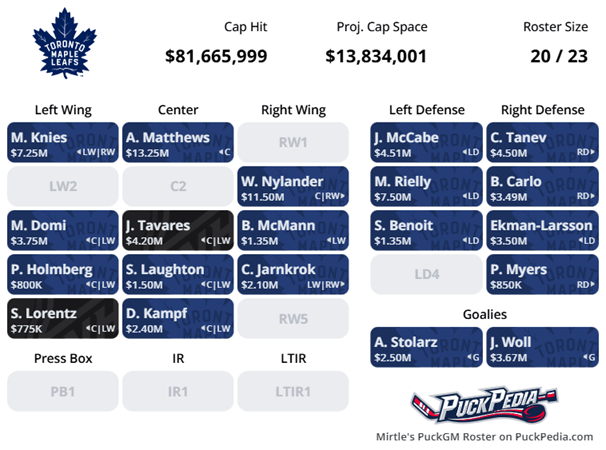
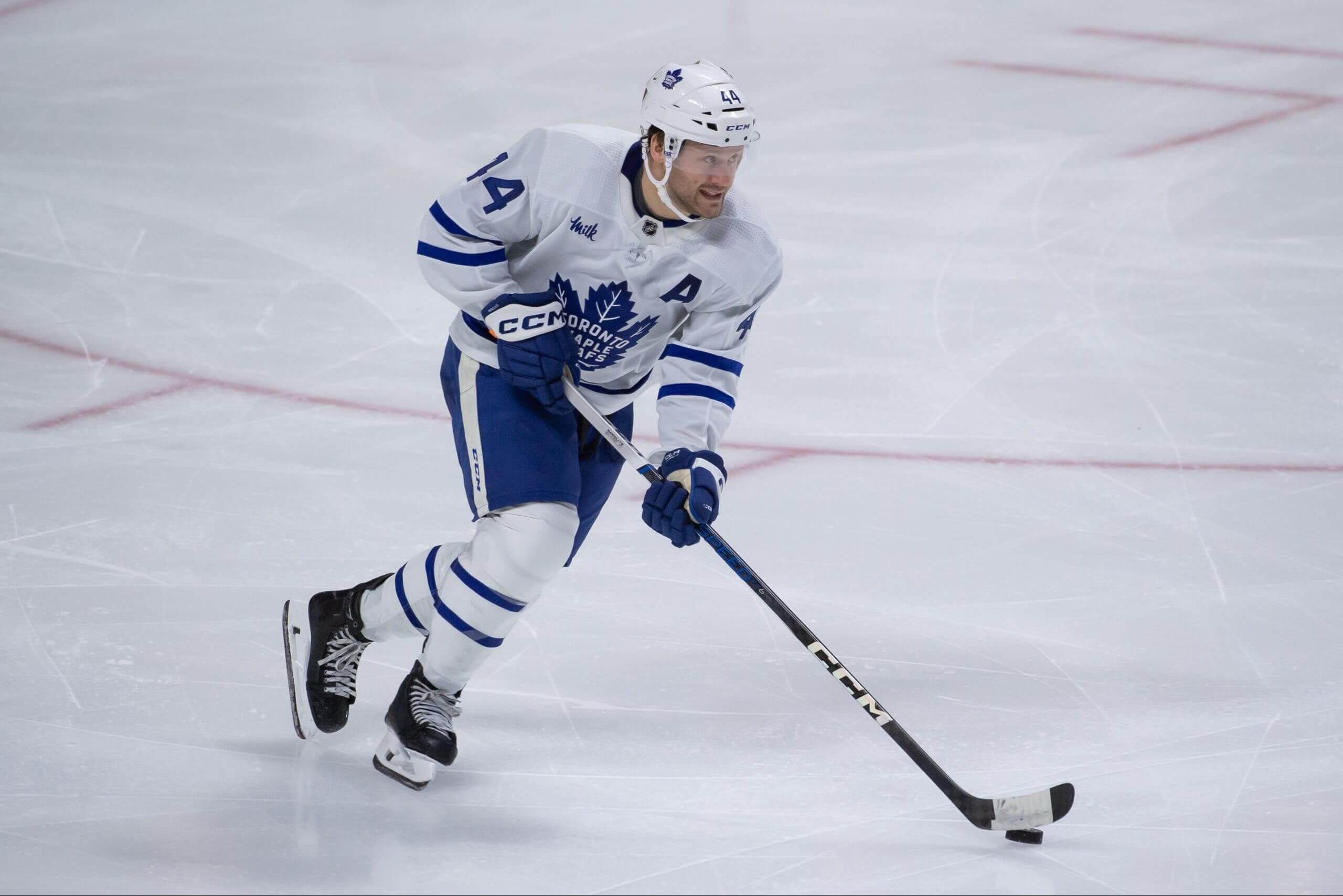
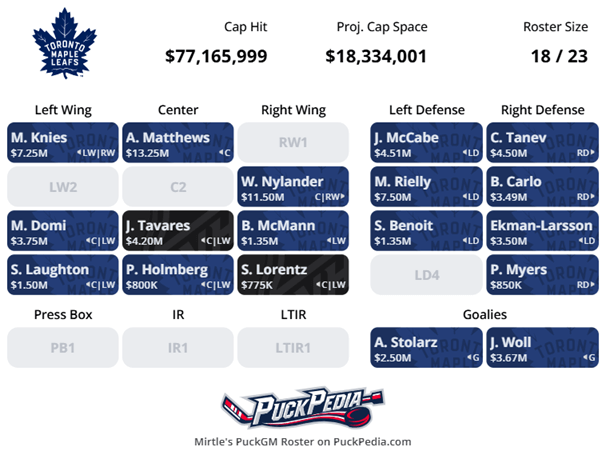
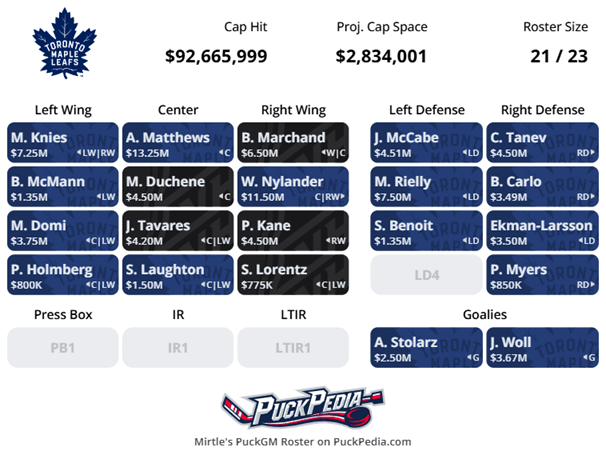

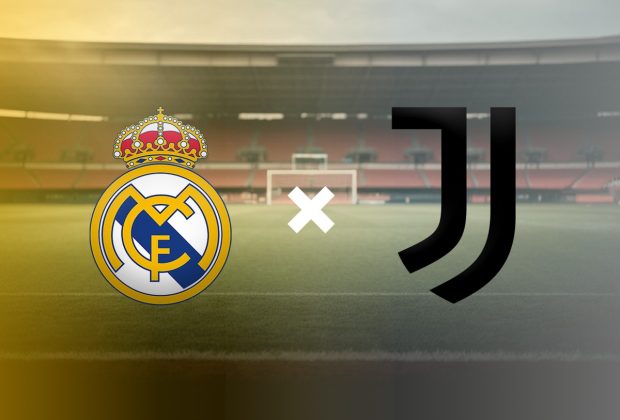



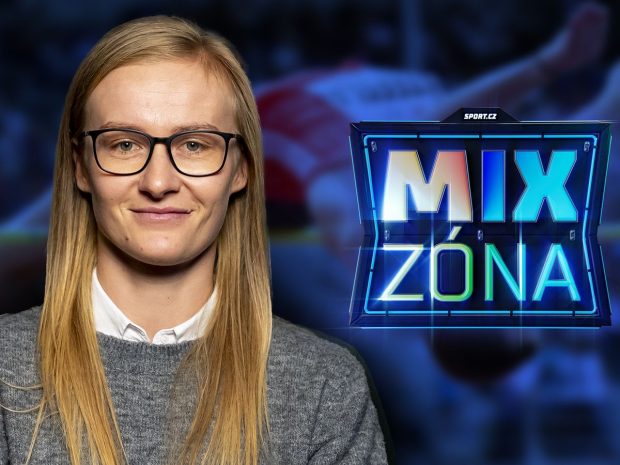

Be the first to leave a comment